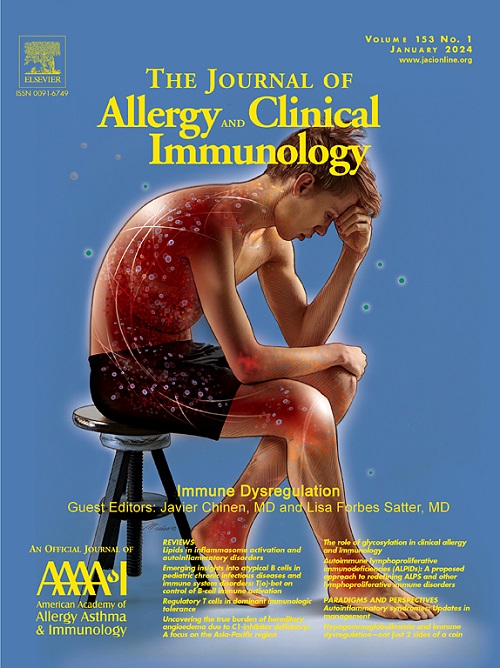Asthma Treatment Response Modified by PM2.5, NO2, and O3 Among African American Children: A Reanalysis of the AsthmaNet's BARD Trial.
IF 11.4
1区 医学
Q1 ALLERGY
引用次数: 0
Abstract
BACKGROUND Asthma morbidity significantly affects children of all racial backgrounds; however, African American children experience a greater disease burden than children from other racial groups. Despite the known influence of air pollution on asthma outcomes, its role in the efficacy of asthma treatments remains underexplored. OBJECTIVE To examine how exposure to particulate matter (PM2.5), nitrogen dioxide (NO2), and ozone (O3) influenced treatment outcomes in the NIH AsthmaNet Best African American Response to Asthma Drugs (BARD) trial. METHODS The BARD trial randomized 224 African American children to four asthma treatments consisting of inhaled corticosteroids (ICS) and long-acting beta antagonists (LABA) administered in a randomized crossover fashion. Treatment efficacy was assessed by the frequency of asthma exacerbations, percent predicted FEV1 (%PFEV1), and annualized asthma control days. Residential exposures to PM2.5, NO2, and O3 were estimated using a validated spatiotemporal model. Mixed effects models were used to evaluate the interaction between pollution exposure and treatment efficacy, adjusting for age, household triggers and trial site. RESULTS PM2.5, NO2, and O3 exposures ranged substantially across participants: from 2.28 - 15.3 μg/m3, 2.34 - 63.7 ppm, and 2.57 - 23.7 ppb, respectively. NO2 and PM2.5 exposures were not associated with increased exacerbations post-treatment (p for interaction = 0.15 and 0.08, respectively). However, NO2 exposure significantly modified the effect of high-dose ICS+LABA therapy on lung function. Children with below median NO2 exposures while on ICS + LABA had a reduction of 5.86 (1.16, 10.56) in %PFEV1 compared to those with above-median NO2 exposures. CONCLUSIONS Residential high NO2 exposure may significantly attenuate the efficacy of ICS+LABA therapy on lung function in African American children. These findings suggest the need to consider environmental factors in clinical trials and asthma management strategies.PM2.5、NO2和O3对非裔美国儿童哮喘治疗反应的影响:对AsthmaNet的BARD试验的再分析
背景:哮喘发病率显著影响所有种族背景的儿童;然而,非裔美国儿童比其他种族的儿童承受更大的疾病负担。尽管已知空气污染对哮喘结果的影响,但其在哮喘治疗效果中的作用仍未得到充分探讨。目的研究暴露于颗粒物(PM2.5)、二氧化氮(NO2)和臭氧(O3)如何影响NIH AsthmaNet非裔美国人对哮喘药物最佳反应(BARD)试验的治疗结果。方法:在BARD试验中,224名非洲裔美国儿童随机接受四种哮喘治疗,包括吸入皮质类固醇(ICS)和长效β拮抗剂(LABA),以随机交叉方式给药。通过哮喘发作频率、预测FEV1百分比(%PFEV1)和哮喘年化控制天数来评估治疗效果。使用经过验证的时空模型估算了PM2.5、NO2和O3的居住暴露。结果pm2.5、NO2和O3的暴露量在受试者中分别为2.28 ~ 15.3 μg/m3、2.34 ~ 63.7 ppm和2.57 ~ 23.7 ppb。NO2和PM2.5暴露与治疗后加重的病情无关(相互作用的p值分别为0.15和0.08)。然而,NO2暴露显著改变了高剂量ICS+LABA治疗对肺功能的影响。低于NO2中位数暴露的儿童在接受ICS + LABA治疗时,与高于NO2中位数暴露的儿童相比,PFEV1 %减少了5.86(1.16,10.56)。结论长期高NO2暴露可能会显著减弱ICS+LABA治疗对非裔美国儿童肺功能的影响。这些发现提示在临床试验和哮喘管理策略中需要考虑环境因素。
本文章由计算机程序翻译,如有差异,请以英文原文为准。
求助全文
约1分钟内获得全文
求助全文
来源期刊
CiteScore
25.90
自引率
7.70%
发文量
1302
审稿时长
38 days
期刊介绍:
The Journal of Allergy and Clinical Immunology is a prestigious publication that features groundbreaking research in the fields of Allergy, Asthma, and Immunology. This influential journal publishes high-impact research papers that explore various topics, including asthma, food allergy, allergic rhinitis, atopic dermatitis, primary immune deficiencies, occupational and environmental allergy, and other allergic and immunologic diseases. The articles not only report on clinical trials and mechanistic studies but also provide insights into novel therapies, underlying mechanisms, and important discoveries that contribute to our understanding of these diseases. By sharing this valuable information, the journal aims to enhance the diagnosis and management of patients in the future.

 求助内容:
求助内容: 应助结果提醒方式:
应助结果提醒方式:


